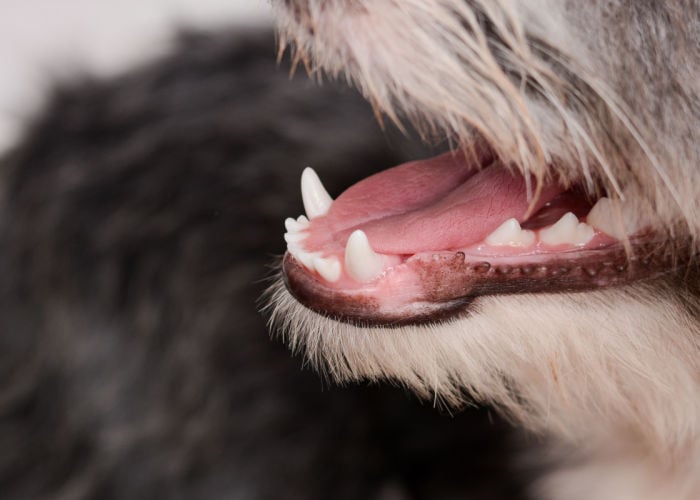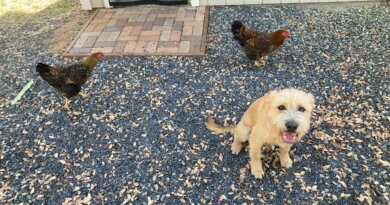How to Prevent Gum Disease in Dogs – Top Dog Tips
Did you notice your dog’s terrible breath as it approached you for a kiss?
Yup, it’s more likely a gum problem.
You’ve come to the right place because you’re about to learn how to prevent gum disease in dogs in a moment.
Does that mean there are several tasks besides brushing my dog’s teeth?
That’s right. By learning more about dental disease in dogs, you will receive more sloppy kisses from your pooch that you’ll enjoy!
Fortunately, we got all the details on dogs’ gum health right here, so make sure to read on!
What is Gum Disease in Dogs?
Did you know that gum disease is the most common dental problem in dogs?
In case you were wondering, dogs are susceptible to many of the same mouth diseases as humans.
However, tooth decay, often known as cavities, is more common in people. Our four-legged companions, on the other hand, are more prone to gum or periodontal disease.
This occurs five times more commonly in dogs than in humans.
The reason?
Compared to us, doggies’ mouths are more alkaline, which encourages plaque growth.
If you don’t brush your pooch’s teeth as needed, food particles and bacteria accumulate at the gum line and solidify into tartar. It results in swollen and inflamed gums in dogs.
This is known as gingivitis, the first stage of periodontal disease.
If gingivitis in dogs is left untreated, the infection often grows further into the tooth socket, eroding the bone. Eventually, the tooth gets loose and may fall out.
What Causes Periodontal Disease in Dogs?
Gum disease in dogs is caused by the buildup of food particles and dental plaque.
But some dogs are more likely than others to develop gum disease.
The American Veterinary Dental Society says that the prevalence of dental disease in dogs has been found to increase with age and decrease with increasing body weight.
This implies that older dogs are most commonly affected by severe gum disease. The older the dog, the longer dental disease can develop.
Fidos of smaller breeds are likewise susceptible. Because of their short muzzles, they’re more likely to develop overcrowding, rotation, and misalignment of the teeth.
This increases the development of teeth tartar, which causes periodontal disease.
Take extra care if you have a toy breed, then! It’s vital that you regularly have your dog’s teeth cleaned.
Have we mentioned that your dog’s immune system also has an impact on their oral health?
When their immune system is weakened, they are more susceptible to infection and less capable of fighting off bacteria.
And not just that.
According to Logan of Veterinary Clinics of North America: Small Animal Practice, gum disease has also been linked to nutritional deficits of vitamins A, C, D, and E.
Even B vitamins such as folic acid, niacin, pantothenic acid, and riboflavin.
In other words, the fewer of these food sources your canine friend consumes, the higher the likelihood that dog gingivitis may develop.
What Do Healthy Gums in Dogs Look Like?
A healthy dog typically has salmon-colored or light bubble-gum pink gums. It pretty much resembles healthy human gums.
But my dog’s gums are dark. Could it be an indication of gum disease?
Other dog breeds may naturally have dark or spotted gums. This is possible and can be normal for your furry child.
It’s also useful to know what your dog’s mouth usually smells like. But as a rule, dog breath should have a mild odor.
Periodontitis in dogs is a distinct possibility if the breath consistently smells bad.
Note that there should be no lumps or swellings around their mouth as well.
Gum Disease in Dogs Signs & Symptoms
Some signs and symptoms of severe gingivitis in dogs you may see include:
- Bad breath
- Loose teeth
- Pawing at the mouth
- Bleeding or red gums
- Bloody or ropey saliva
- Problems picking up food
- Bumps or lumps in the mouth
- Chewing on one side of the mouth
- Excessive drooling or discharge from the mouth
Unfortunately, dog parents hardly ever notice gum disease symptoms in their dogs.
In the early stages of gum disease, our pawed friends frequently show no visible signs.
You can keep the worst from happening to your Fido by making it a habit to check their mouth.
As dog parents, we are responsible for our dogs’ gum health. We should pay attention to symptoms before the disease worsens and possibly harms Fido.
Dental disease in dogs cannot be reversed. Therefore, you should take your furry friend to the vet so they can thoroughly examine the mouth to see if they show any of the symptoms.
Your vet may advise you on how to prevent gum disease in dogs and your next steps.
Stages of Periodontal Disease in Dogs
Periodontal diseases in dogs have four stages.
That’s right.
Each stage exhibits distinct symptoms and demands a different course of action.
That’s why you need to be aware of where your fur baby’s condition stands at this point.
Stage 1: Gingivitis
Though dog gingivitis may sound bad, the mouth is actually still in good shape at this stage. Dental calculus might have begun to show up, but it’s not guaranteed.
Finding a red line on your Fido’s gum next to its teeth will help you easily identify gingivitis.
Stage 2: Early Periodontitis in Dogs
You’ll observe swollen and inflamed gums in dogs at this stage. They have trouble eating and become grumpy if you touch their mouth.
That’s because the gums become sensitive, and your doggo’s mouth is painful.
Another observable sign is bad breath.
Stage 3: Moderate Periodontitis in Dogs
Stage 2 will already make me anxious for my dog! How much more for stage 3?
Well, reaching the third stage should be avoided. At this point, severe periodontal damage has already occurred, negatively impacting your four-legged pal’s overall health.
Infection is causing damage to the gum, which is now bleeding and bright red. Bad breath is also a recurring problem.
Stage 4: Advanced Periodontitis in Dogs
Unfortunately, significant and irreversible damage has already taken place.
The fourth stage of periodontitis in dogs is regarded as extreme since it has become chronic. There is a lot of bleeding, severe inflammation, and bone loss.
There will be a need for medical care.
Note: Dog gingivitis is the only stage that is reversible. That means it can be handled with a professional dental cleaning to stop plaque buildup.
How to Prevent Gum Disease in Dogs
No dog parent wants their dog to suffer from diseases, whether they are reversible or irreversible.
Dental disease in dogs can cause more problems than tooth pain, especially if left untreated.
This can result in other health problems in the body, such as kidney disease or heart problems.
This can occur when the bacteria in the mouth enter the bloodstream via inflamed gums and infect other organs.
Well, that would be a nightmare for both you and your dog.
So what should I do?
There are many different approaches to providing Fido with oral health preventative care.
But we are sharing with you the simplest and most attainable tips on how to prevent gum disease in dogs.
Brush Your Dog’s Teeth
I know. You’ve probably heard this a hundred times regarding dogs’ oral health.
And we will remind you of it again because it works. We’re putting it first on the list as it makes a big difference when done correctly and consistently.
The old adage, “Prevention is better than cure,” can be applied to your pooch’s dental health. And doing so for your dog will save you financially in the long run.
It’s an important part of a dog’s grooming routine, just as it is for humans. It’s the simplest and most effective way to prevent gingivitis in dogs.
But how often should my dog’s teeth be brushed?
Ideally, it’s something you should do daily.
The best time for brushing their teeth is after eating or drinking. By doing this, you can rinse any food residue from their mouth before it causes plaque build-up between their teeth.
Brushing their teeth twice daily is even better for dogs’ gum health. But if it is unrealistic for you, try doing so at the end of each day or before bedtime.
Knowing how to brush your dog’s teeth is important, which is why we created easy-to-follow steps that can work for you and your pooch.
We can also help you choose the most suitable toothbrush for your dog’s breed.
But remember that brushing is not the only solution how to prevent gum disease in dogs. That’s why I suggest you keep reading.
When You Can’t Brush Fido’s Teeth
What if it becomes difficult to brush my dog’s teeth?
Let’s keep things real. While some do not have this problem with their pawed friends, other fur parents do have difficulty when it comes to brushing their dog’s teeth.
Fortunately, dental treats may help. A study evidenced the oral health benefits of dental chews and their effectiveness in reducing plaque and calculus build-up on tooth surfaces.
In fact, some vets now recommend giving your dog dental chews.
This is a great option for Fidos that don’t seem to like getting their mouth wet.
You must mix the chews into your dog’s food so they’ll have something to lick while eating.
Tip: You may look for the Veterinary Oral Health Council seal to ensure you’re getting an effective product. This indicates that the product meets certain pre-standards.
Good Nutrition
It’s a no-brainer that a healthy diet contributes to your dog’s strong gums and teeth.
Start by feeding your furry friend a high-quality diet of whole meats and other organic ingredients. Even better, add herbs and supplements to improve their dental health.
The ideal environment for your dog’s healthy oral microbiome is provided by natural diets.
It can prevent the growth of tartar by naturally occurring live enzymes and “good” bacteria.
You’ll find out at my next point if you want to know a few of my favorites.
What Food is Good for Dogs’ Gums?
Here are some foods that can prevent canine gum disease.
Cranberries
You can give them to your Fido in any way you want: dried, raw, or cooked.
Cranberries are tasty treats that can help prevent bacteria from adhering to their gums and teeth.
It’s all thanks to the components that act as bioactive molecules in the treatment of dental diseases.
Keep in mind, though, to start with small portions in your dog’s diet to avoid an upset stomach.
What about cranberry sauce?
We would have to say no.
Remember to watch for sugar and other additives when feeding your dog cranberry products.
Cranberry sauce is likely to have a high sugar content. The same holds true for commercially produced juices and sweet treats.
Oats
Oats are known to have a plethora of nutrients and minerals, particularly potassium, calcium, phosphorus, and magnesium.
They are a nutritive food that helps maintain healthy gums and teeth and also acts as a tonic for the blood and nerves.
Make sure you cook the oatmeal. If you sprinkle them raw over their food, it will be more difficult for your dog to digest.
Dill
Dill’s culinary and medicinal benefits have long been known.
The good news is that it benefits not only man but also man’s best friend.
According to Herbs for Pets by Tilford and Wulff, the dill’s ability to freshen breath is attributed to its antibacterial properties, which are effective in the mouth for bad breath caused by bacteria and even gingivitis.
If you keep it on hand in the kitchen, consider making a dill seed tea to feed your doggie. Make it with a tablespoon of dill seed to 8 oz. of water.
Schedule Regular Oral Exams and Cleanings For Your Dog
Just because you don’t notice any issues with your dog’s oral health doesn’t mean oral exams aren’t necessary.
Unfortunately, some dog parents forego veterinary dental cleanings and oral exams because of this.
According to the American Kennel Club, two-thirds of dog owners neglect their dog’s oral hygiene.
As a fur parent, I’ve learned that preventative measures at home and veterinary visits are all worthwhile when it comes to my dog’s dental hygiene.
Because of this, my dog, Baste, has had healthy gums and teeth for the past six years.
He doesn’t have any trouble eating, and his smiles are the most beautiful!
As mentioned, this is not only for Fido’s general well-being and comfort but also for your budget.
It always pays to start early!
Dental Treats and Chews
Keeping your dog’s gums and teeth free of plaque by providing them with dental chews can also work.
This help cleans their teeth by scraping off the bacteria that cause bad breath and any food debris.
But how can I check for plaque build-up in my dog?
When you lift your dog’s head to inspect its teeth, you will notice a soft, sticky film coating them. It will look more yellow the more plaque there is.
Dental chews, when used in conjunction with routine cleaning, are effective in reducing bacteria and tartar build-up, according to Dr. Morrison, director of vet science at Banfield Animal Hospital.
In addition, some dental chews have an anti-plaque chemical ingredient like delmopinol. It’s a patented dog-safe ingredient found in VOHC-approved OraVet dog chews.
OraVet Dental Hygiene Chews are the only dental chews that contain this ingredient.
They recommend giving your dog one treat daily to help form a protective barrier on their teeth that keeps bacteria at bay.
When shopping for dental chews, also take into account factors such as nutritional information and size.
They should be the right size for your dog since they can be a choking hazard.
Dog dental treats such as Greenies, Pedigree Dentastix, and Milk-Bone Original Brushing Chews are unsuitable for doggies under six months old.
How is Periodontal Disease in Dogs Treated?
It depends on the stage.
Professional dental cleanings and fluoride applications to reduce plaque buildup are effective treatments for gingivitis.
A full set of dental radiographs (x-rays), pre-anesthesia blood work, an IV catheter, and IV fluids may be required for doggo in more severe stages.
How Much Does it Cost to Treat Gum Disease in Dogs?
The typical price range for cleaning your dog’s teeth is $300 to $700.
But you should expect the whole cost to vary between $2,000 and $3,000 if your dog needs complete cleaning, scaling, extractions, and X-rays.
How to Prevent Gum Disease in Dogs: FAQs
Can you cure gum disease in dogs?
Daily brushing and good oral hygiene practices can treat gingivitis. If caught early enough, it’s both preventable and reversible.
A vet may also give nonsteroidal anti-inflammatory medicines to alleviate the pain produced by gum infection.
The only treatment option for teeth in stage 4 is extraction.
How long does it take dog gums to heal fully?
Normally, this takes two weeks. Your vet will recommend that you give your dog soft food and forego brushing their teeth for a few days to a week.
Make sure to wait until the surgical site has fully healed before giving your dog a hard kibble.
What color is unhealthy dog gum?
The gum color of a sick doggo may be pale white, blue, black, or red.
Anemia may be indicated by pale gums. If the gums are yellow, your dog may have liver issues.
You should also seek medical help if their gums are blue. It could be brought on by heart problems or poisoning.
How to Prevent Gum Disease in Dogs: Takeaways
Knowing how to prevent gum disease in dogs can make a difference in their lives.
Not only in their lives but yours as well.
You’ve learned that dental disease in dogs and its treatments can be very expensive. Your dog suffers, as well as your wallet!
But now that you have all the information you need, you can save not only your dog’s gum health but also its overall well-being.
They can play with other dogs and go long walks without experiencing dental discomfort. Doggo will enjoy its food and appreciate you more.
Plus, kisses that you’ll enjoy!
READ NEXT: 7 Foods and Chews for Dog’s Dental Health (Backed by Science)








